Control of Tropical Landcover and Soil Properties on Landslides’ Aquifer Recharge, Piezometry and Dynamics
Abstract
:1. Introduction
2. Materials and Methods
2.1. Description of the Study Site
2.1.1. Localization
2.1.2. Rainfall
2.1.3. Activity of the Grand Ilet Landslide
2.1.4. Geological and hydrogeological setting
- The Grand Ilet debris-avalanche breccias form the lower and thickest unit of the landslide. The breccias form the aquifer (1 × 10−5 m/s < K < 1 × 10−4 m/s) and result from the landslide’s movement. They consist of angular fragments of aphyric basalt or with olivine phenocrysts. The size of such fragments varies from a few centimeters to several meters. They are contained in an unconsolidated sandy matrix. The thickness of this unit varies between 30 and 100 m. The landslide’s slipping surface is materialized by a meter-thick clayed breccia located at the base of this unit [62]. In this clayed breccia, the size of the elements appears greatly reduced: their diameter does not exceed a few centimeters. The matrix shows significant plasticity when it is saturated with water and many shear zones are observed, with striated plans. The breccias are indurated under the landslide’s base.
- The superficial deposits are breccias (K = 5 × 10−3 m/s) deriving from the differentiated basalt from the rampart forming the upper unit of the landslide. It consists of decimeter- to meter-sized blocks, again in an unconsolidated sandy matrix. Its thickness varies from a few to several tens of meters and it overlies the lower unit of Grand Ilet breccia.
2.2. Hydrologic Monitoring Network
2.2.1. Precipitation
2.2.2. Potential Evapotranspiration
2.2.3. Monitoring Surface-Water and Groundwater Flows
2.3. Theory and Calculation: Evaluating the Water Balance Components
2.3.1 Architecture of the Water Balance
- Rampart watershed: The Cimendef rampart.
- Comparison of computed annual recharge with the calculated outflow;
- Comparison of the piezometric aquifer response to each computed recharge episode.
2.3.2. Estimating the Runoff Coefficient and Aquifer Response to Recharge
2.3.3 Calculating Recharge Volumes from Piezometric Variations
3. Results
3.1. Estimating Outflow from the Grand Ilet Landslide
3.2. Hydrodynamic Response of the Aquifer
3.3. Breakdown of the Hydrograph and Runoff Coefficient
3.4. Water Budget
3.5. Validation of the Water Budget from Piezometric Variations
4. Discussion
4.1. Hydrological Processes
4.2. Landslide Activity
4.3. Implications, Limits and Perspectives
5. Conclusions
Supplementary Materials
Author Contributions
Funding
Acknowledgments
Conflicts of Interest
References
- Gutiérrez, F.; Soldati, M.; Audemard, F.; Bălteanu, D. Recent advances in landslide investigation: Issues and perspectives. Geomorphology 2010, 124, 95–101. [Google Scholar] [CrossRef]
- Varnes, D.J. Slope Movement Types and Processes; Transportation Research Board: Washington, DC, USA, 1978; pp. 11–33. [Google Scholar]
- Terzaghi, K. Mechanisms of Landslides; Geological Society of America: Boulder, CO, USA, 1950; pp. 83–123. [Google Scholar]
- Nemčok, A.; Pašek, J.; Rybář, J. Classification of landslides and other mass movements. Rock Mech. 1972, 4, 71–78. [Google Scholar] [CrossRef]
- Cruden, D.M.; Varnes, D.J. Landslides Types and Processes; National Academy of Sciences: Washington, DC, USA, 1996; pp. 36–75. [Google Scholar]
- Popescu, M.E. Landslides Causal Factors and Landslide Remediatial Options. In Proceedings of the 3rd International Conference Landslides, Slope Stability and Safety of Infra-Structures, Singapore, 11–12 July 2002; pp. 61–81. [Google Scholar]
- Iverson, R.M.; Major, J.J. Rainfall, ground-water flow and seasonal movement at Minor Creek landslide, northwestern California: Physical interpretation of empirical relations. Geol. Soc. Am. 1987, 99, 579–594. [Google Scholar] [CrossRef]
- Baum, R.L.; Reid, M.E. Geology, Hydrology and Mechanics of the Alani-Paty Landslide, Manoa Valley, Oahu, Hawaii; USGS: Reston, VA, USA, 1992; p. 87.
- van Asch, T.W.J.; Buma, J.; Van Beek, L.P. A view on some hydrological triggering systems in landslides. Geomorphology 1999, 30, 25–32. [Google Scholar] [CrossRef]
- Coe, J.; Ellis, W.; Godt, J.; Savage, W.; Savage, J.; Michael, J.; Kibler, J.; Powers, P.; Lidke, D.; Debray, S. Seasonal movement of the Slumgullion landslide determined from Global Positioning System surveys and field instrumentation, July 1998–March 2002. Eng. Geol. 2003, 68, 67–101. [Google Scholar] [CrossRef]
- Cappa, F.; Guglielmi, Y.; Soukatchoff, V.M.; Mudry, J.; Bertrand, C.; Charmoille, A. Hydromechanical modeling of a large moving rock slope inferred from slope levelling coupled to spring long-term hydrochemical monitoring: Example of the La Clapière landslide (Southern Alps, France). J. Hydrol. 2004, 291, 67–90. [Google Scholar] [CrossRef]
- Iverson, R.M. Landslide triggering by rain infiltration. Water Resour. Res. 2000, 36, 1897–1910. [Google Scholar] [CrossRef] [Green Version]
- Rutqvist, J.; Stephansson, O. The role of hydromechanical coupling in fractured rock engineering. Hydrogeol. J. 2003, 11, 7–40. [Google Scholar] [CrossRef] [Green Version]
- Bernardie, S.; Desramaut, N.; Malet, J.-P.; Gourlay, M.; Grandjean, G. Prediction of changes in landslide rates induced by rainfall. Landslides 2015, 12, 481–494. [Google Scholar] [CrossRef]
- Malet, J.P.; Van Asch, T.W.G.; Van Beek, R.; Maquaire, O. Forecasting the behaviour of complex landslides with a spatially distributed hydrological model. Nat. Hazards Earth Syst. Sci. 2005, 5, 71–85. [Google Scholar] [CrossRef] [Green Version]
- Matsuura, S.; Asano, S.; Okamoto, T. Relationship between rain and/or meltwater, pore-water pressure and displacement of a reactivated landslide. Eng. Geol. 2008, 101, 49–59. [Google Scholar] [CrossRef]
- Berti, M.; Simoni, A. Observation and analysis of near-surface pore-pressure measurements in clay-shales slopes. Hydrol. Process. 2012, 26, 2187–2205. [Google Scholar] [CrossRef]
- Tacher, L.; Bonnard, C.; Laloui, L.; Parriaux, A. Modelling the behaviour of a large landslide with respect to hydrogeological and geomechanical parameter heterogeneity. Landslides 2005, 2, 3–14. [Google Scholar] [CrossRef]
- François, B.; Tacher, L.; Bonnard, C.; Laloui, L.; Triguero, V. Numerical modelling of the hydrogeological and geomechanical behaviour of a large slope movement: The Triesenberg landslide (Liechtenstein). Can. Geotech. J. 2007, 44, 840–857. [Google Scholar] [CrossRef]
- Schulz, W.; McKenna, J.; Kibler, J.; Biavati, G. Relations between hydrology and velocity of a continuously moving landslide—evidence of pore-pressure feedback regulating landslide motion? Landslides 2009, 6, 181–190. [Google Scholar] [CrossRef]
- Brocca, L.; Ponziani, F.; Moramarco, T.; Melone, F.; Berni, N.; Wagner, W. Improving landslide forecasting using ASCAT-derived soil moisture data: A case study of the Torgiovannetto landslide in central Italy. Remote Sens. 2012, 4, 1232–1244. [Google Scholar] [CrossRef]
- Ponziani, F.; Pandolfo, C.; Stelluti, M.; Berni, N.; Brocca, L.; Moramarco, T. Assessment of rainfall thresholds and soil moisture modeling for operational hydrogeological risk prevention in the Umbria region (central Italy). Landslides 2012, 9, 229–237. [Google Scholar] [CrossRef]
- Belle, P.; Aunay, B.; Bernardie, S.; Grandjean, G.; Ladouche, B.; Mazué, R.; Join, J.-L. The application of an innovative inverse model for understanding and predicting landslide movements (Salazie cirque landslides, Reunion Island). Landslides 2014, 11, 343–355. [Google Scholar] [CrossRef]
- Vallet, A.; Charlier, J.B.; Fabbri, O.; Bertrand, C.; Carry, N.; Mudry, J. Functioning and precipitation-displacement modelling of rainfall-induced deep-seated landslides subject to creep deformation. Landslides 2016, 13, 653–670. [Google Scholar] [CrossRef]
- Corominas, J.; Moya, J.; Ledesma, A.; Lloret, A.; Gili, J. Prediction of ground displacements and velocities from groundwater level changes at the Vallcebre landslide (Eastern Pyrenees, Spain). Landslides 2005, 2, 83–96. [Google Scholar] [CrossRef]
- Padilla, C.; Onda, Y.; Iida, T.; Takahashi, S.; Uchida, T. Characterization of the groundwater response to rainfall on a hillslope with fractured bedrock by creep deformation and its implication for the generation of deep-seated landslides on Mt. Wanitsuka, Kyushu Island. Geomorphology 2014, 204, 444–458. [Google Scholar] [CrossRef]
- Travelletti, J.; Sailhac, P.; Malet, J.-P.; Grandjean, G.; Ponton, J. Hydrological response of weathered clay-shale slopes: Water infiltration monitoring with time-lapse electrical resistivity tomography. Hydrol. Process. 2012, 26, 2106–2119. [Google Scholar] [CrossRef]
- Debieche, T.-H.; Bogaard, T.A.; Marc, V.; Emblanch, C.; Krzeminska, D.M.; Malet, J.-P. Hydrological and hydrochemical processes observed during a large-scale infiltration experiment at the Super-Sauze mudslide (France). Hydrol. Process. 2012, 26, 2157–2170. [Google Scholar] [CrossRef]
- Bièvre, G.; Jongmans, D.; Winiarski, T.; Zumbo, V. Application of geophysical measurements for assessing the role of fissures in water infiltration within a clay landslide (Trièves area, French Alps). Hydrol. Process. 2012, 26, 2128–2142. [Google Scholar] [CrossRef] [Green Version]
- Parriaux, A.; Bonnard, C.; Tacher, L. Glissements de Terrain: Hydrogéologie et Techniques D’assainissement Par Drainage; Office fédéral de l’environnement: Berne, Switzerland, 2010; p. 128. (In French) [Google Scholar]
- van Asch, T.W.J.; Van Beek, L.P.; Bogaard, T. Problems in predicting the mobility of slow-moving landslides. Eng. Geol. 2007, 91, 46–55. [Google Scholar] [CrossRef]
- Tullen, P. Méthodes D’analyse du Fonctionnement Hydrogéologique des Versants Instables; Ecole polytechnique fédérale de Lausanne: Lausanne, Switzerland, 2002. (In French) [Google Scholar]
- Maréchal, J.C.; Lachassagne, P.; Ladouche, B.; Dewandel, B.; Lanini, S.; Strat, P.; Petelet-Giraud, E. Structure and hydrogeochemical functioning of a sparkling natural mineral water system determined using a multidisciplinary approach: A case study from southern France. Hydrogeol. J. 2014, 22, 47–68. [Google Scholar] [CrossRef]
- Guglielmi, Y.; Bertrand, C.; Compagnon, F.; Follacci, J.; Mudry, J. Acquisition of water chemistry in a mobile fissured basement massif: Its role in the hydrogeological knowledge of the La Clapière landslide (Mercantour massif, southern Alps, France). J. Hydrol. 2000, 229, 138–148. [Google Scholar] [CrossRef]
- Binet, S.; Mudry, J.; Scavia, C.; Campus, S.; Bertrand, C.; Guglielmi, Y. In situ characterization of flows in a fractured unstable slope. Geomorphology 2007, 86, 193–203. [Google Scholar] [CrossRef] [Green Version]
- Binet, S.; Jomard, H.; Lebourg, T.; Guglielmi, Y.; Tric, E.; Bertrand, C.; Mudry, J. Experimental analysis of groundwater flow through a landslide slip surface using natural and artificial water chemical tracers. Hydrol. Process. 2007, 21, 3463–3472. [Google Scholar] [CrossRef] [Green Version]
- Charlier, J.-B.; Bertrand, C.; Binet, S.; Mudry, J.; Bouillier, N. Use of continuous measurements of dissolved organic matter fluorescence in groundwater to characterize fast infiltration through an unstable fractured hillslope (Valabres rockfall, French Alps). Hydrogeol. J. 2010, 18, 1963–1969. [Google Scholar] [CrossRef] [Green Version]
- Vallet, A.; Bertrand, C.; Mudry, J.; Bogaard, T.; Fabbri, O.; Baudement, C.; Régent, B. Contribution of time-related environmental tracing combined with tracer tests for characterization of a groundwater conceptual model: A case study at the Séchilienne landslide, western Alps (France). Hydrogeol. J. 2015, 23, 1761–1779. [Google Scholar] [CrossRef]
- Guglielmi, Y.; Vengeon, J.; Bertrand, C.; Mudry, J.; Follacci, J.; Giraud, A. Hydrogeochemistry: An investigation tool to evaluate infiltration into large moving rock masses (case study of La Clapière and Séchilienne alpine landslides). Bull. Eng. Geol. Environ. 2002, 61, 311–324. [Google Scholar] [CrossRef]
- Tullen, P.; Turberg, P.; Parriaux, A. Radiomagnetotelluric mapping, groundwater numerical modelling and 18-Oxygen isotopic data as combined tools to determine the hydrogeological system of a landslide prone area. Eng. Geol. 2006, 87, 195–204. [Google Scholar] [CrossRef]
- Vallet, A.; Bertrand, C.; Mudry, J. Effective rainfall: A significant parameter to improve understanding of deep-seated rainfall triggering landslide – a simple computation temperature based method applied to Séchilienne unstable slope (French Alps). Hydrol. Earth Syst. Sci. Discuss. 2013, 10, 8945–8991. [Google Scholar] [CrossRef]
- Terlien, M.T.J. Hydrological landslide triggering in ash-covered slopes of Manizales (Columbia). Geomorphology 1997, 20, 165–175. [Google Scholar] [CrossRef]
- Larsen, M.C.; Torres-Sánchez, A.J. The frequency and distribution of recent landslides in three montane tropical regions of Puerto Rico. Geomorphology 1998, 24, 309–331. [Google Scholar] [CrossRef] [Green Version]
- Nagarajan, R.; Roy, A.; Vinod Kumar, R.; Mukherjee, A.; Khire, M.V. Landslide hazard susceptibility mapping based on terrain and climatic factors for tropical monsoon regions. Bull. Eng. Geol. Environ. 2000, 58, 275–287. [Google Scholar] [CrossRef]
- Anderson, M.G.; Kemp, M.F. Towards an improved specification of slope hydrology in the analysis of slope instability problems in the tropics. Prog. Phys. Geogr. 1991, 15, 29. [Google Scholar] [CrossRef]
- Anderson, M.G.; Collison, A.J.C.; Hartshorne, J.; Lloyd, D.M.; Park, A. Developments in Slope Hydrology-Stability Modelling for Tropical Slopes; Anderson, M.G., Brooks, S.M., Eds.; Wiley: Chichester, UK, 1996; Volume 2, pp. 799–821. [Google Scholar]
- Collison, A.J.C.; Anderson, M.G. Using a combined slope hydrology/stability model to identify suitable conditions for landslide prevention by vegetation in the humid tropics. Earth Surf. Process. Landf. 1996, 21, 737–747. [Google Scholar] [CrossRef]
- Fernandes, N.F.; Guimarães, R.F.; Gomes, R.A.T.; Vieira, B.C.; Montgomery, D.R.; Greenberg, H. Topographic controls of landslides in Rio de Janeiro: Field evidence and modeling. Catena 2004, 55, 163–181. [Google Scholar] [CrossRef]
- Join, J.-L.; Coudray, J.; Longworth, K. Using principal components analysis and Na/Cl ratios to trace groundwater circulation in a volcanic island: The example of Reunion. J. Hydrol. 1997, 190, 1–18. [Google Scholar] [CrossRef]
- Join, J.-L.; Folio, J.-L.; Robineau, B. Aquifers and groundwater within active shield volcanoes. Evolution of conceptual models in the Piton de la Fournaise volcano. J. Volcanol. Geotherm. Res. 2005, 147, 187–201. [Google Scholar] [CrossRef]
- Charlier, J.-B.; Lachassagne, P.; Ladouche, B.; Cattan, P.; Moussa, R.; Voltz, M. Structure and hydrogeological functioning of an insular tropical humid andesitic volcanic watershed: A multi-disciplinary experimental approach. J. Hydrol. 2011, 398, 155–170. [Google Scholar] [CrossRef]
- Rouquet, S.; Boivin, P.; Lachassagne, P.; Ledoux, E. A 3-D genetic approach for the high resolution geological modelling of the volcanic infill of a paleovalley system. Application to the Volcanic catchment (Chaîne des Puys, France). Bull. Soc. Geol. Fr. 2012, 183, 395–407. [Google Scholar] [CrossRef]
- Lachassagne, P.; Aunay, B.; Frissant, N.; Guilbert, M.; Malard, A. Hydrogeological Conceptual Model of a Complex Basaltic Volcanic islands. The Mayotte, Comores, Case Study; Terra Nova: Santa Fe, NM, USA, 2014. [Google Scholar]
- Météo-France. Atlas Climatique de La Réunion; Météo-France: Saint-Denis, France, 2011; p. 132. [Google Scholar]
- Garnier, C. Etude du glissement de terrain de grande ampleur de Grand Ilet, Cirque de Salazie-Ile de la Réunion; Bureau de Recherches Géologiques et Minières (BRGM): Paris, Franch, 2008; p. 74. (In French) [Google Scholar]
- Deniel, C.; Kieffer, G.; Lecointre, J. New 230Th-238U and 14C age determinations from Piton des Neiges volcano, Reunion—A revised chronology for the differentiated series. J. Volcanol. Geotherm. Res. 1992, 51, 253–267. [Google Scholar] [CrossRef]
- Oehler, J.-F.; Labazuy, P.; Lénat, J.-F. Recurrence of major flank landslides during the last 2-Ma-history of Reunion Island. Bull. Volcanol. 2004, 66, 585–598. [Google Scholar] [CrossRef]
- Oehler, J.-F.; Lénat, J.-F.; Labazuy, P. Growth and collapse of the Reunion Island volcanoes. Bull. Volcanol. 2008, 70, 717–742. [Google Scholar] [CrossRef]
- Arnaud, N. Les Processus de Démantèlement des Volcans, le cas d’un Volcan Bouclier en Milieu Océanique: Le Piton des Neiges. Ph.D. Thesis, Université de la Réunion, Saint-Denis, La Réunion, 2005. (In French). [Google Scholar]
- Famin, V.; Michon, L. Volcano destabilization by magma injections in a detachment. Geology 2010, 28, 219–222. [Google Scholar] [CrossRef]
- Belle, P. Contribution des Processus Hydrologiques et Hydrogéologiques aux Glissements de Terrain de Grande Ampleur: Application au Contexte Tropical de La Réunion. Ph.D. Thesis, Université de La Réunion, Saint-Denis, La Réunion, April 2014. [Google Scholar]
- Pinchinot, H. Etude Géologique des Formations Superficielles et du Proche Substratum à Grand Ilet (Cirque de Salazie, La Réunion). Application à la Cartographie du Risque de Mouvements de Versants. Ph.D. Thesis, Université scientifique et médicale de Grenoble, Grenoble, Franch, October 1984. (In French). [Google Scholar]
- Raunet, M. Le Milieu Physique et Les Sols de l’île de La Réunion. Conséquences Pour la Mise en Valeur Agricole; Centre de Coopération Internationale en Recherche Agronomique Pour le (CIRAD): Paris, Franch, 1991; p. 515. (In French) [Google Scholar]
- Courtois, N.; Lachassagne, P.; Wyns, R.; Blanchin, R.; Bougaïré, F.D.; Somé, S.; Tapsoba, A. large-scale mapping of hard-rock aquifer properties applied to Burkina Faso. Groundwater 2009, 48, 269–283. [Google Scholar] [CrossRef] [PubMed]
- Singh, V.P. Hydrologic Systems: Watershed Modeling; Prentice-Hall: Bergen, NJ, USA, 1989; Volume 2. [Google Scholar]
- Xu, C.-Y.; Singh, V.P. Evaluation and generalization of temperature-based methods for calculating evaporation. Hydrol. Process. 2001, 15, 305–319. [Google Scholar] [CrossRef] [Green Version]
- Tabari, H.; Hosseinzadeh Talaee, P.; Some’e, B.S. Spatial modelling of reference evapotranspiration using adjusted Blaney-Criddle equation in an arid environment. Hydrol. Sci. J. 2013, 58, 408–420. [Google Scholar] [CrossRef] [Green Version]
- Blaney, H.F.; Criddle, W.D. Determining Water Needs from Climatological Data; USDA Soil Conservation Service: Washington, DC, USA, 1950. [Google Scholar]
- Bargeas, A. Evaluation Globale de la Ressource en eau de l’île de la Réunion; Apports de la Simulation par Modèles Hydrologiques; Bureau de Recherches Géologiques et Minières (BRGM): Orléans, France, 1984; p. 384. [Google Scholar]
- Szydłowski, M.; Szpakowski, W.; Zima, P. Numerical simulation of catastrophic flood: The case study of hypothetical failure of the Bielkowo hydro-power plant reservoir. Acta Geophys. 2013, 61, 1229–1245. [Google Scholar] [CrossRef]
- Chen, C.-N.; Tsai, C.-H.; Wu, M.-H.; Tsai, C.-T. Numerical simulation of potential inundation in a coastal zone. J. Flood Risk Manag. 2013, 8, 208–223. [Google Scholar] [CrossRef]
- Feng, Y.; Burian, S.; Pomeroy, C. Potential of green infrastructure to restore predevelopment water budget of a semi-arid urban catchment. J. Hydrol. 2016, 542, 744–755. [Google Scholar] [CrossRef]
- Rouquet, S.; Lachassagne, P.; Ledoux, E. Forest Cover Distributed Hydrological Modelling at the Catchment Scale. In Forest and the Water Cycle: Quantity, Quality, Management; Cambridge Scholars Publishing: Newcastle upon Tyne, UK, 2016; Volume 2.5, pp. 153–180. [Google Scholar]
- Klaassen, W.; Bosveld, F.; de Water, E. Water storage and evaporation as constituents of rainfall interception. J. Hydrol. 1998, 212–213, 36–50. [Google Scholar] [CrossRef]
- Barcelo, A. Analyse des Mécanismes Hydrologiques en Domaine Volcanique Insulaire Tropical à Relief Jeune. Apports de la Connaissance du Bilan Hydrique. Massif de La Fournaise (île de la Réunion). Ph.D. Thesis, Université de la Réunion, Saint-Denis, La Réunion, 1996. (In French). [Google Scholar]
- Bessière, H.; Allier, D. Méthode de Quantification Spatiale des Ressources en eau Souterraine de lîle de La Réunion; Bureau de Recherches Géologiques et Minières (BRGM): Orléans, France, 2011; p. 178. (In French) [Google Scholar]
- Lacoste, V.; Daesslé, M. Etude Hydrogéologique et Géophysique de Grand Ilet, Technical Report. 2003; 44. (In French)
- Hewlett, J.D.; Hibbert, A.R. Factors Affecting the Response of Small Watersheds to Precipitation in Humid Areas; Pergamon Press-Oxford & New York: New York, NY, USA, 1965. [Google Scholar]
- Charlier, J.-B.; Cattan, P.; Moussa, R.; Voltz, M. Hydrological behaviour and modelling of a volcanic tropical cultivated catchment. Hydrol. Process. 2008, 22, 4355–4370. [Google Scholar] [CrossRef]
- Castany, G. Traité pratique des eaux souterraines; Dunod: Paris, France, 1963. [Google Scholar]
- Jackson, J.A. Relationships between rainfall parameters and interception by tropical forest. J. Hydrol. 1975, 24, 215–238. [Google Scholar] [CrossRef]
- Payet, N.; Findeling, A.; Chopart, J.-L.; Feder, F.; Nicolini, E.; Saint Macary, H.; Vauclin, M. Modelling the fate of nitrogen following pig slurry application on a tropical cropped acid soil on the island of Réunion (France). Agric. Ecosyst. Environ. 2009, 134, 218–233. [Google Scholar] [CrossRef]
- Chopart, J.-L.; Mézino, M.; Nativel, R. Fluctuation Saisonnière de l’Evapotranspiration (ET0 Penman-Monteith) Dans le Nord, l’Est et le Sud-est de l’île de la Réunion. Ifluence de l’altitude et Comparaison Avec l’Ouest et le Sud; Centre de Coopération Internationale en Recherche Agronomique Pour le (CIRAD): Paris, France, 2003; p. 21. [Google Scholar]
- Lachassagne, P.; Rouquet, S.; Lafforgue, M. Main Quantitative Hydrological Concepts. In Forest and the Water Cycle: Quantity, Quality, Management; Cambridge Scholars Publishing: Newcastle upon Tyne, UK, 2016; pp. 23–38. [Google Scholar]
- Lachassagne, P. Synthesis-Interactions between Forest and Water Resources: Quantitative Impacts. In Forest and the Water Cycle: Quantity, Quality, Management; Cambridge Scholars Publishing: Newcastle upon Tyne, UK, 2017; pp. 570–585. [Google Scholar]
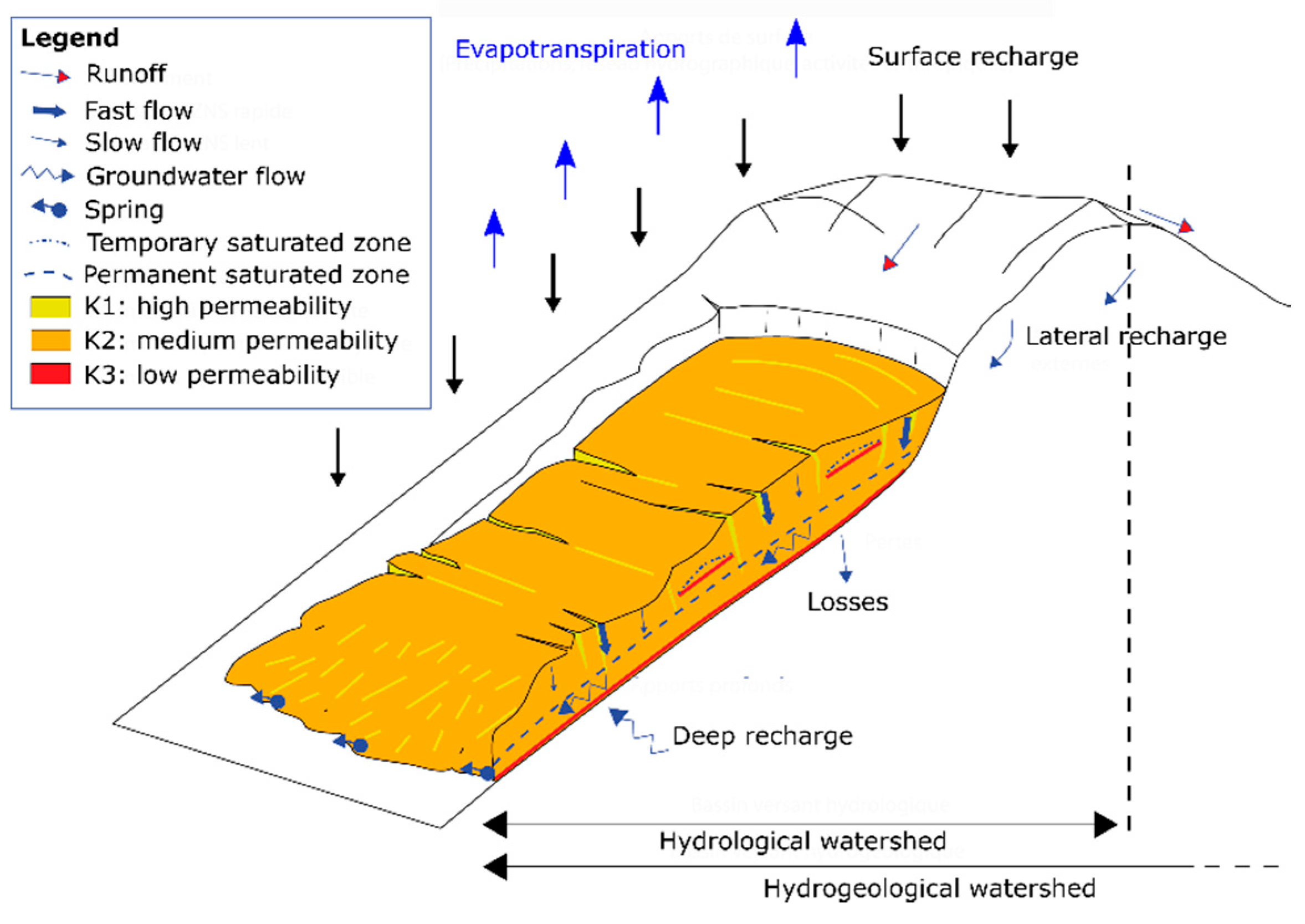
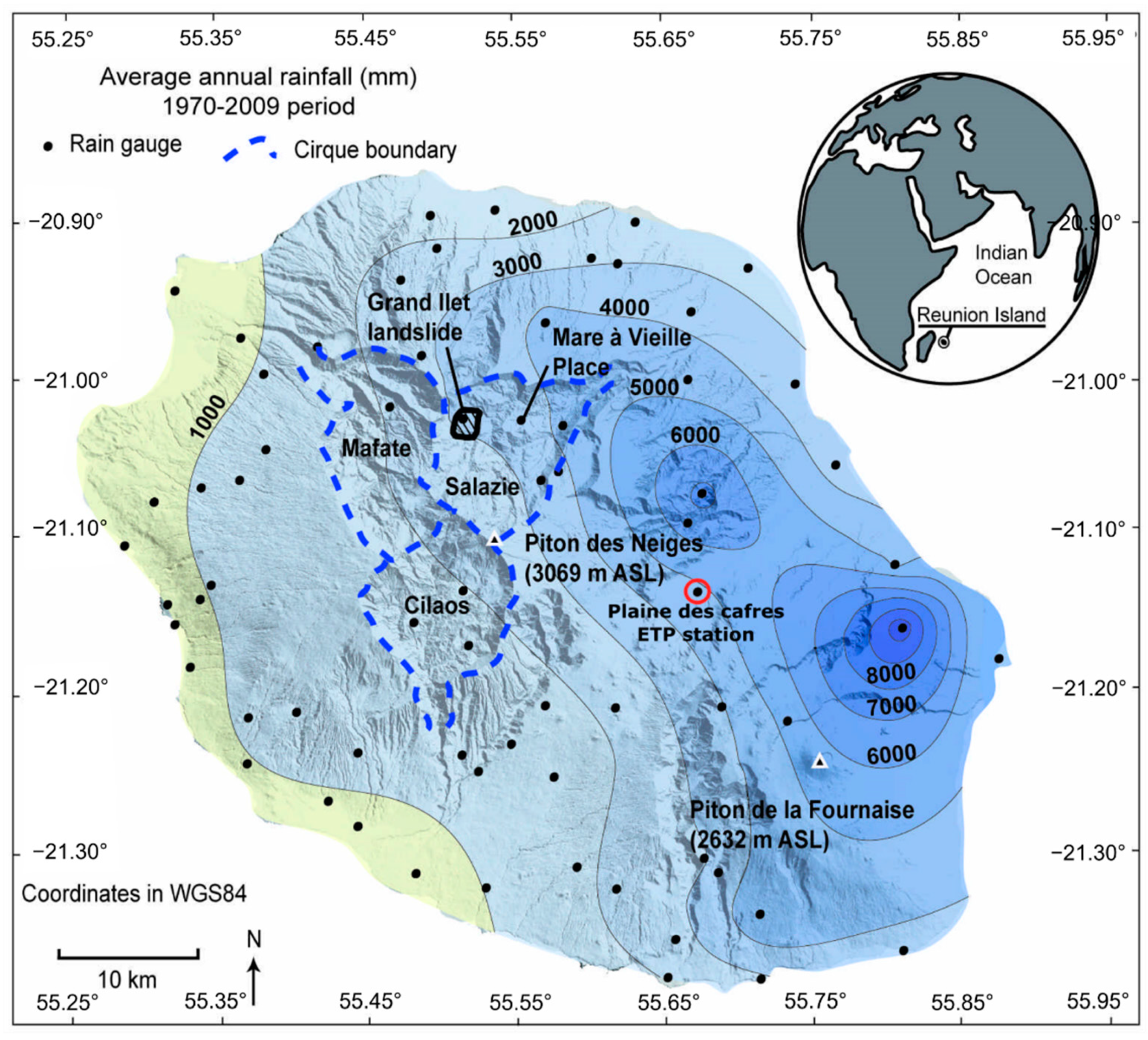
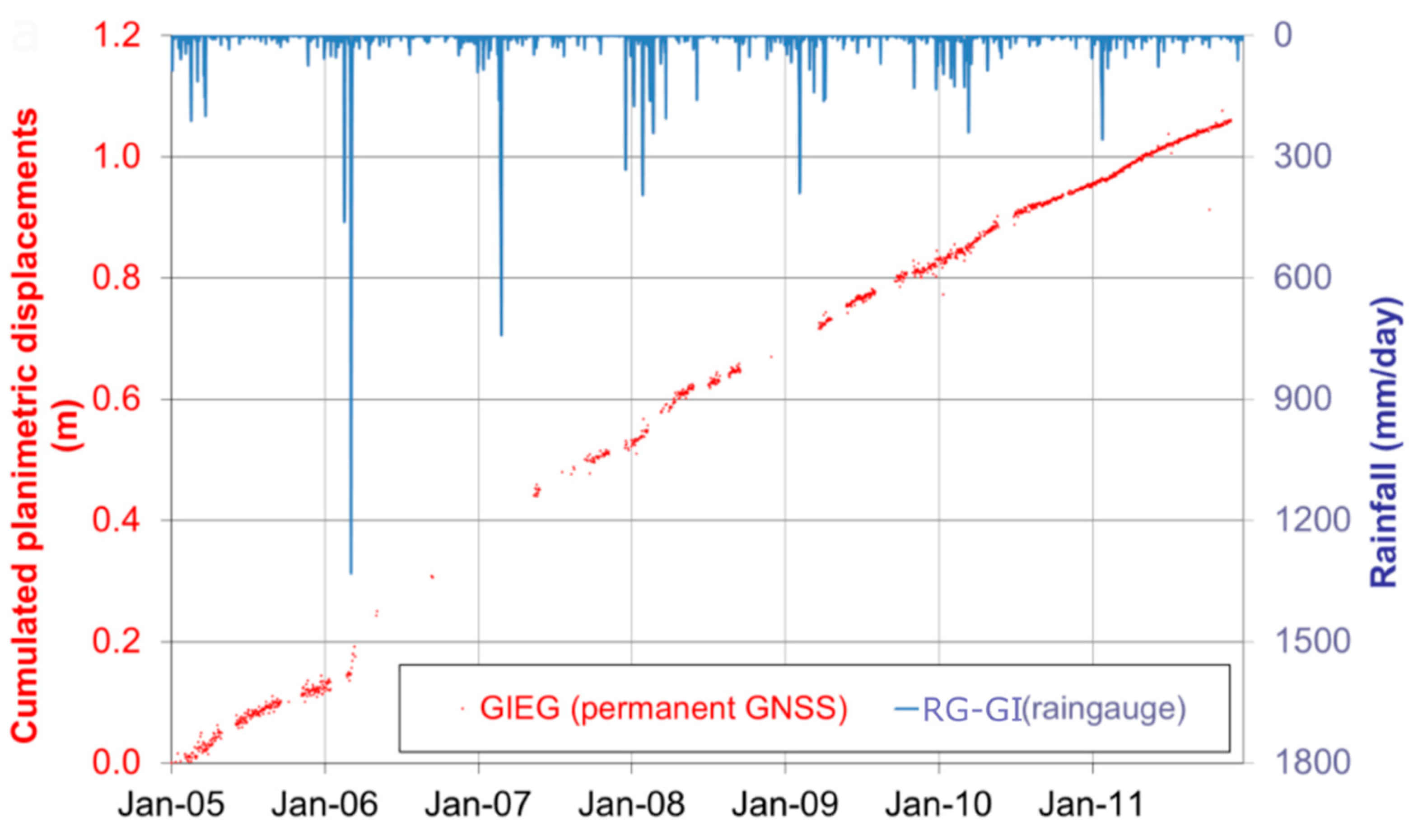
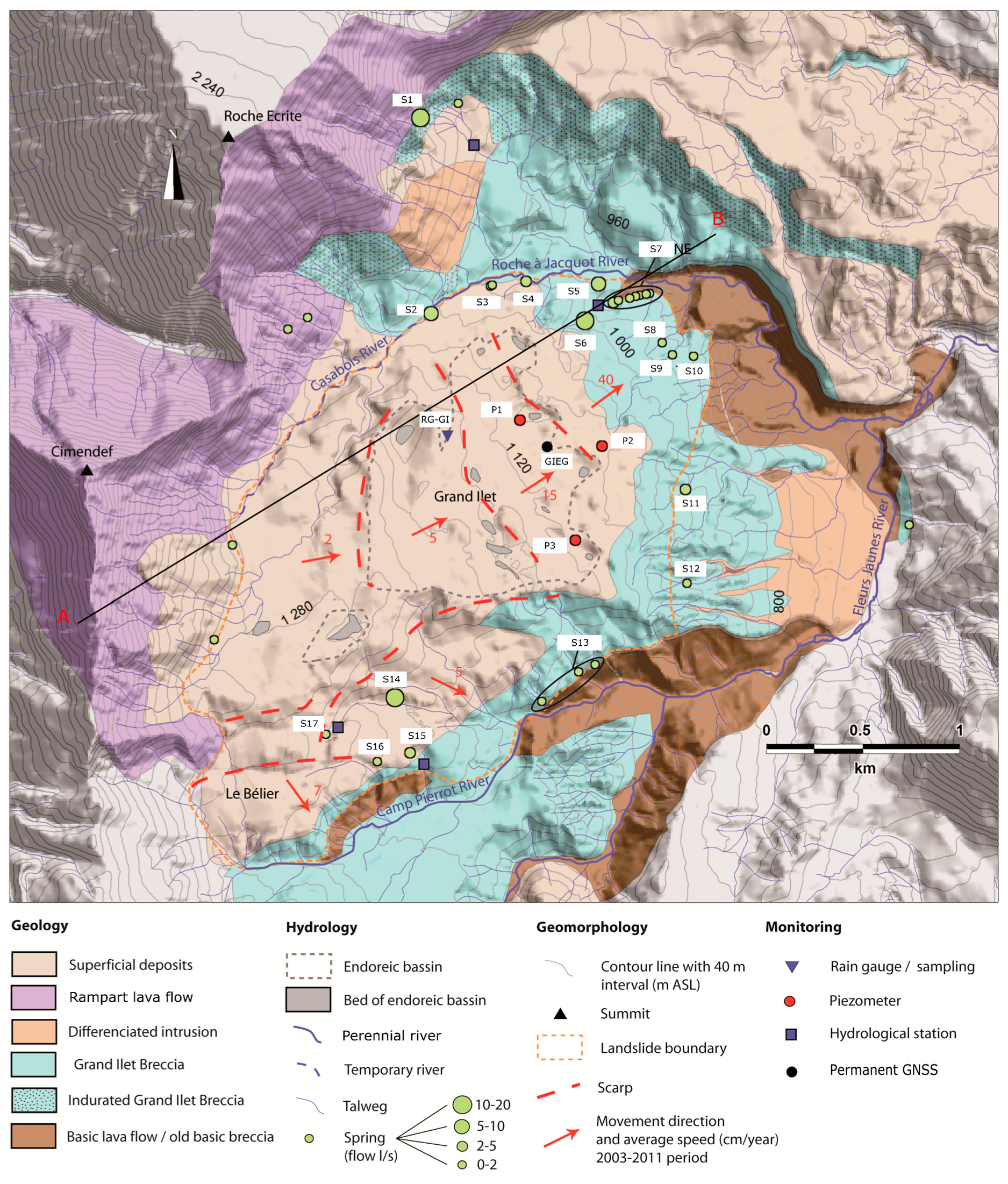
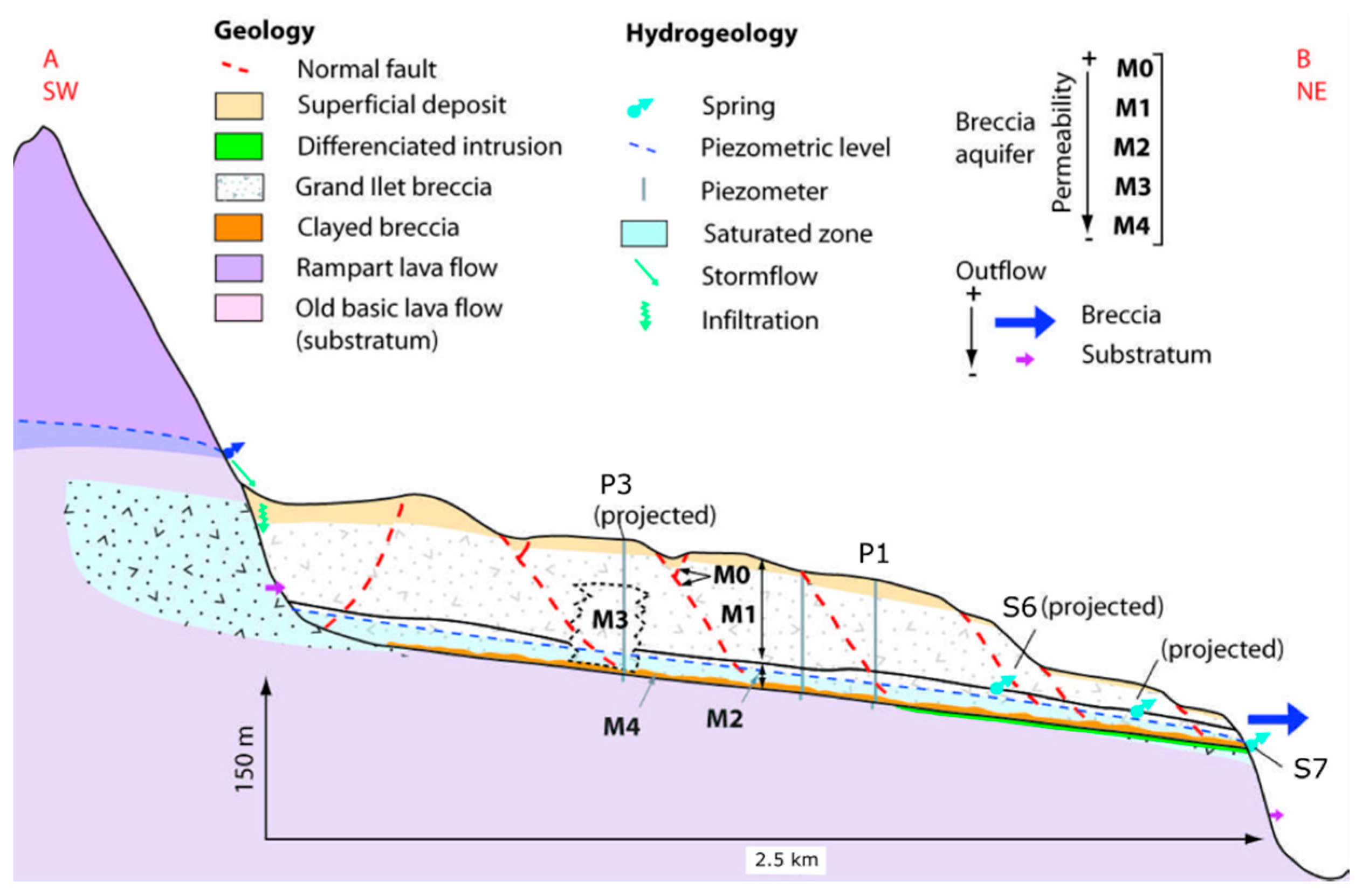

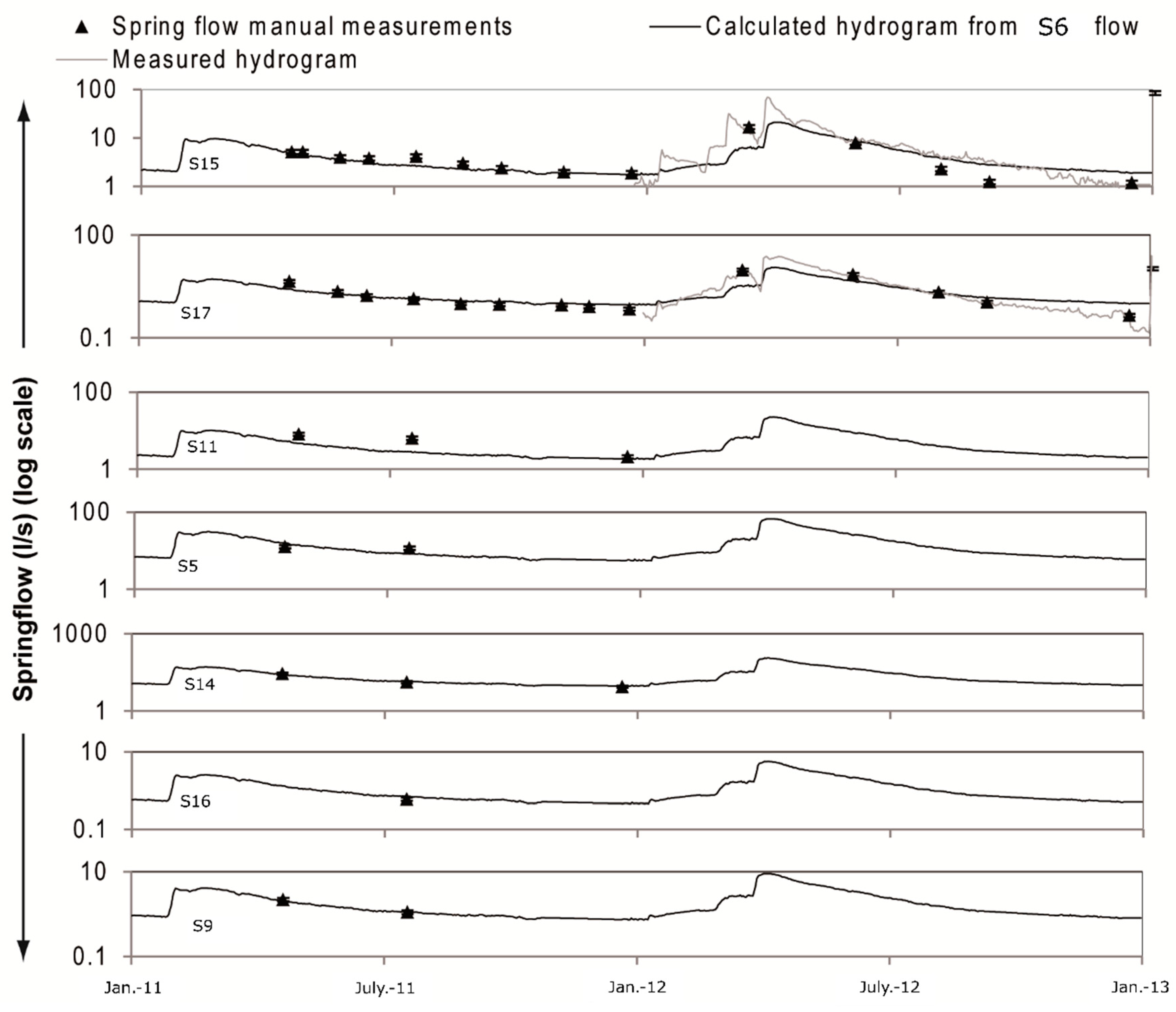

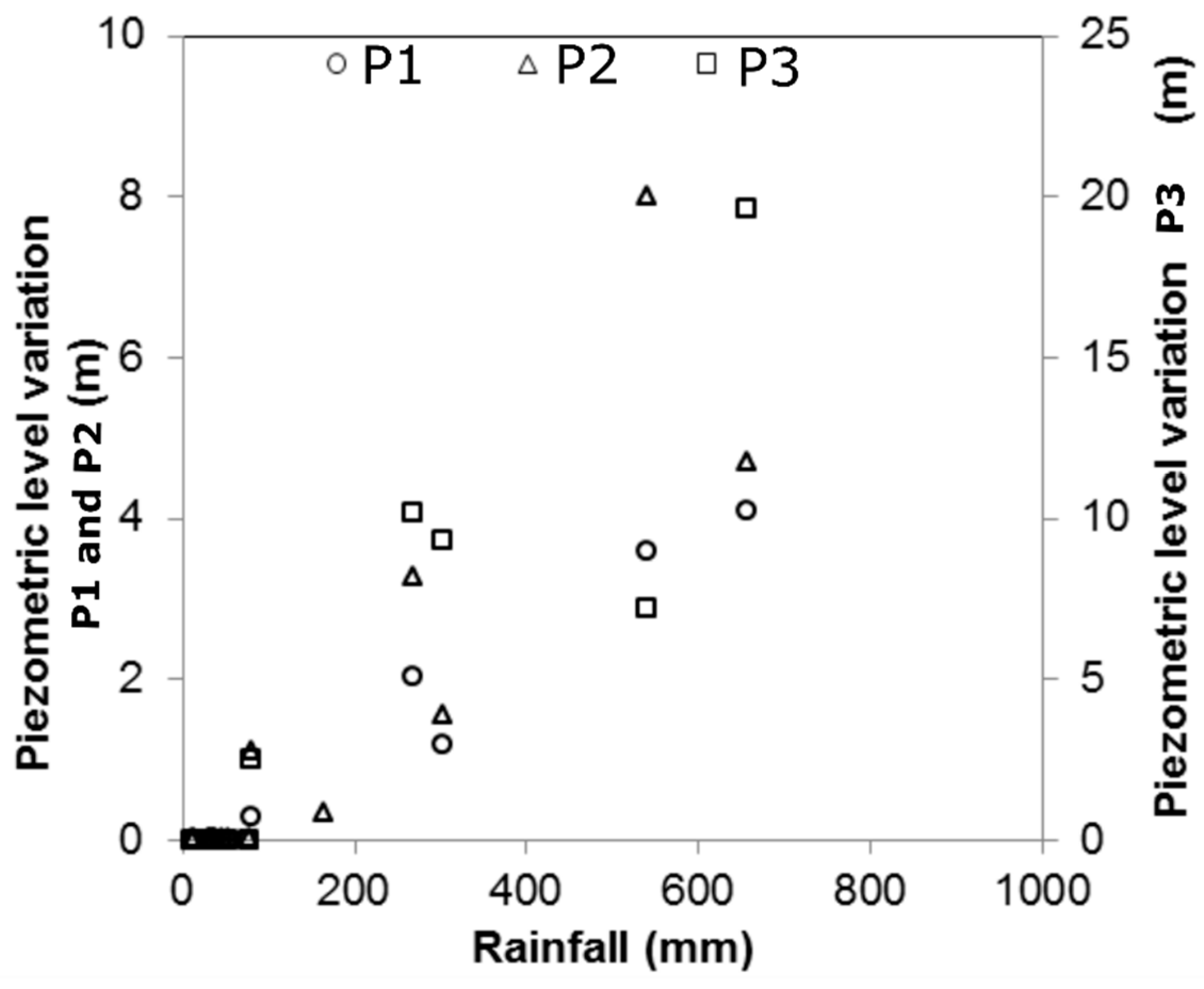

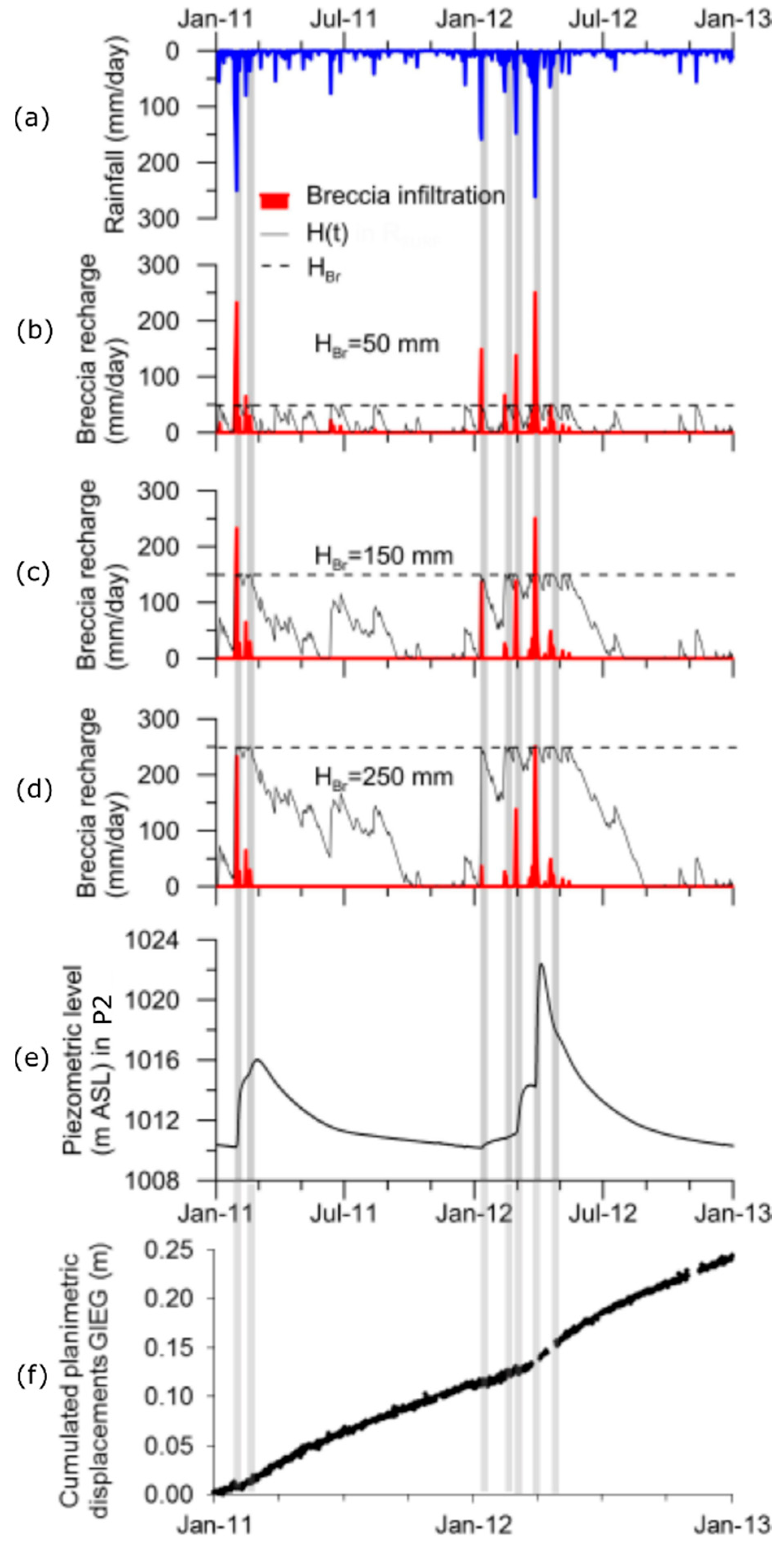
| Spring. | Q LW (l/s) | (Q LW)/(Q S6) | 2011 | 2012 | ||||||
|---|---|---|---|---|---|---|---|---|---|---|
| Monitoring Type | Measured Annual Flow (m3/year) | Estimated Annual Flow (m3/year) | Annual Flow Part (%) | Monitoring Type | Measured Annual Flow (m3/year) | Estimated Annual Flow (m3/year) | Annual Flow Part (%) | |||
| S6 | 20.0 | 1.00 | C | 1,175,977 | - | 37.3 | C | 1,801,863 | - | 36.6 |
| S7 | 3.0 | 0.15 | VE | - | 176,397 | 5.6 | VE | - | 270,279 | 5.5 |
| S9 | 0.8 | 0.04 | PM | - | 47,039 | 1.5 | PM | - | 72,075 | 1.5 |
| S8 | 0.5 | 0.03 | VE | - | 29,399 | 0.9 | VE | - | 45,047 | 0.9 |
| S5 | 6.0 | 0.30 | PM | - | 352,793 | 11.2 | PM | - | 540,559 | 11.0 |
| S4 | 3.0 | 0.15 | PM | - | 176,397 | 5.6 | PM | - | 270,279 | 5.5 |
| S3 | 0.5 | 0.03 | VE | - | 29,399 | 0.9 | VE | - | 45,047 | 0.9 |
| S11 | 2.0 | 0.10 | PM | - | 117,598 | 3.7 | PM | - | 180,186 | 3.7 |
| S10 | 1.0 | 0.05 | VE | - | 58,799 | 1.9 | VE | - | 90,093 | 1.8 |
| S15 | 1.9 | 0.10 | PM | - | 146,997 | 4.7 | C | 257,143 | - | 5.2 |
| S16 | 0.5 | 0.03 | PM | - | 29,399 | 0.9 | PM | - | 45,047 | 0.9 |
| S17 | 0.8 | 0.04 | PM | - | 47,039 | 1.5 | C | 131,096 | - | 2.7 |
| S14 | 10.0 | 0.50 | PM | - | 587,989 | 18.7 | PM | - | 900,932 | 18.3 |
| S13 | 3.0 | 0.15 | VE | - | 176,397 | 5.6 | VE | - | 270,279 | 5.5 |
| Total measured outflow (m3/year) | - | - | - | 1,175,977 | - | - | - | 2,190,101 | - | - |
| Total estimated outflow (m3/year) | - | - | - | - | 1,975,642 | - | - | - | 2,729,823 | - |
| Total outflow (m3/year) | - | - | - | 3,151,619 | - | - | 4,919,924 | |||
| Parameters | Short-Form Expression | Quantification Method |
|---|---|---|
| Potential Evapotranspiration | PETBC | Calculation based on temperature (Blanley-Criddle equation) |
| Rainfall | R | Measured with tipping-bucket rain gauge |
| Runoff | S | Measured with gauging weirs |
| Date (First Day of Rainfall during the Episode under Consideration) | Cumulated Rainfall (mm) | Length (day) |
|---|---|---|
| 29 January 2011 | 655 | 4 |
| 12 February. 2011 | 80 | 1 |
| 10 January 2012 | 303 | 2 |
| 12 February 2012 | 164 | 4 |
| 29 February 2012 | 267 | 3 |
| 29 March 2012 | 541 | 3 |
| Period | 2011 | 2012 | 2011 | 2012 | 2011 | 2012 | |
|---|---|---|---|---|---|---|---|
| Calibration Parameters | HBr Breccias (mm) | 250 | 150 | 50 | |||
| HRamp Rampart (mm) | 50 | 50 | 50 | ||||
| Results | Outflow from springs (m3/year) | 3,151,619 | 4,919,924 | 3,151,619 | 4,919,924 | 3,151,619 | 4,919,924 |
| Calculated outflow for the model (m3/year) | 2,997,815 | 5,831,608 | 3,407,230 | 6,241,023 | 4,161,024 | 6,852,124 | |
| Deviation (%) | −5 | 19 | 8 | 27 | 32 | 39 | |
| Period | 2011 | 2012 | 2011–2012 | |||
|---|---|---|---|---|---|---|
| Watershed | Breccia | Rampart | Breccia | Rampart | Breccia | Rampart |
| Rainfall R (mm) | 2143 | 2143 | 2634 | 2634 | 4777 | 4777 |
| Number of Recharge Episodes | 2 | 10 | 5 | 9 | 7 | 19 |
| Actual Evapotranspiration ET (mm) | 1548 | 761 | 1443 | 739 | 2990 | 1500 |
| Runoff S (mm) | 25 | 663 | 26 | 902 | 51 | 1565 |
| Infiltration Ar (mm) | 555 | 682 | 1174 | 1008 | 1728 | 1690 |
| Remaining stock in the soil reservoir (mm) | 15 | 37 | 8 | 23 | 8 | 23 |
| S/R (%) | 1 | 31 | 1 | 34 | 1 | 33 |
| ET/R (%) | 72 | 36 | 55 | 28 | 63 | 31 |
| Ar/R (%) | 26 | 32 | 45 | 38 | 36 | 35 |
© 2018 by the authors. Licensee MDPI, Basel, Switzerland. This article is an open access article distributed under the terms and conditions of the Creative Commons Attribution (CC BY) license (http://creativecommons.org/licenses/by/4.0/).
Share and Cite
Belle, P.; Aunay, B.; Lachassagne, P.; Ladouche, B.; Join, J.-L. Control of Tropical Landcover and Soil Properties on Landslides’ Aquifer Recharge, Piezometry and Dynamics. Water 2018, 10, 1491. https://doi.org/10.3390/w10101491
Belle P, Aunay B, Lachassagne P, Ladouche B, Join J-L. Control of Tropical Landcover and Soil Properties on Landslides’ Aquifer Recharge, Piezometry and Dynamics. Water. 2018; 10(10):1491. https://doi.org/10.3390/w10101491
Chicago/Turabian StyleBelle, Pierre, Bertrand Aunay, Patrick Lachassagne, Bernard Ladouche, and Jean-Lambert Join. 2018. "Control of Tropical Landcover and Soil Properties on Landslides’ Aquifer Recharge, Piezometry and Dynamics" Water 10, no. 10: 1491. https://doi.org/10.3390/w10101491
APA StyleBelle, P., Aunay, B., Lachassagne, P., Ladouche, B., & Join, J.-L. (2018). Control of Tropical Landcover and Soil Properties on Landslides’ Aquifer Recharge, Piezometry and Dynamics. Water, 10(10), 1491. https://doi.org/10.3390/w10101491






